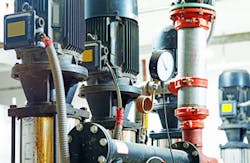Consideration factors in assessing filtration systems
Filtration removes physical particles from liquid streams and prevents contamination or equipment damage. To select the right filtration system, consider the following.
Is the reason for filtering to prevent human exposure to toxic materials? Is it to prevent wear and abrasion inside machinery?
Consider factors such as flow, volume and whether equipment can go offline frequently or for long periods of time while maintaining the filtration system.
Cost-wise, give consideration not only to front-end costs, but also to potential long-term and incremental costs related to maintenance, media replacement and eventual upgrades.
Below is useful information related to types of filtration, when each is needed, and where to find potential cost savings.
Triad of types
Of the three basic types of liquid filtration typically applied, each has its benefits and costs.
Take into account initial price in addition to replacement, disposal and labor costs.
Bag filters – typically where flow levels and volumes are low. Bag filters generate less solid waste than cartridge filters, which is a significant benefit if a goal is to reduce hazardous waste. However, if you expect frequent filter replacement, bag filters aren’t the economical choice. Additionally, bag filters can be used in conjunction with a clean-in-place (CIP) filter system’s waste line so that waste liquids containing solid contaminants can be recycled.
Cartridge filters – similar to bag filters in terms of cost and replacement frequency – assuming bag filters are not to be recycled. Functionally, cartridge filters are used for low flow rates and volumes. However, as noted, cartridge filters can generate 10-15 times the solid waste a bag filter produces, and installation typically costs more. Additionally, since cartridge filters cannot be reused like bag filters, replacement costs can end up being more.
Clean-in-Place (CIP) filters – are often used in settings that see high flow rates and volumes. They are considered beneficial in cases where workers should not be exposed to the process liquid or when filter media replacement costs are too high. CIP systems can filter suspended solids as small as one micron. A potential downside is that the initial cost is higher on the front end — although that higher cost can be negated later, once disposal, replacement and labor are factored in.
Cost considerations
As a rule of thumb, disposal of a used bag or cartridge costs about half the purchase price. The cost can go even higher if hazardous materials are involved. For the best comparison between filter types, know the following:
- Flow rate and anticipated volume
- Characteristics of the media being filtered: viscosity, chemical makeup, temperature
- General characteristics of the solids being removed: size, chemical makeup and other
- Whether materials being filtered out are hazardous and can be recycled back into the process during a different phase
- Whether the application is a continuous-production or batch-process system
- Waste disposal costs
- Expected frequency for media replacement
- Waste reduction or elimination following from switch to different type filtration system
- Replacement labor and downtime costs
- Downtime reduction following from replacement
Why upgrade or add?
A filter system upgrade or replacement costs real money, and facilities managers decide against it when the risk of a costly failure caused by solids in process fluids is slight. However, incremental and hidden costs associated with contaminants can add up.
Paper making – Suspended solids can prematurely damage an expensive membrane system if not removed early. Manufacturers see the risk and use pre-filters (either bag or CIP) upstream of the membrane system to significantly reduce it.
Spray nozzles – A filtration system will reduce wear that can damage a spray nozzle by catching solid particles before they get to it. Additionally, they prevent particles from being sprayed through the nozzles.
Plastic molding and extrusion – In these type operations, it is common for cooling water to be contaminated with airborne particulates, lime scale and plastic particles. Manufacturers can reduce equipment wear and ultimately cut maintenance costs by removing suspended solids with a filtration system. This means less downtime and lower utility costs.
Stainless steel – Manufacturing stainless steel — for knives, as an example — requires very clean water to cool the molding machinery, and manufacturers often must rely on city water to meet the right standards. However, some manufacturers are able to use less expensive well water instead by adding a stainless steel CIP filter to make it as clean as city-treated water. Depending on volume, it can save thousands of dollars annually.
A smart filtration decision can reduce downtime, cut waste disposal costs, rein in maintenance costs, protect workers from unsafe materials and improve product quality. Facilities managers should review all options for filtration systems and seek out as much information as possible from system engineers, process specialists, and filter manufacturers when considering their installation or upgrade.
Jeff Mare is the Product Specialist at Eaton Filtration Online, an online supplier of Eaton filtration products (housings and filters) for an extensive selection of liquid handling and filtration needs. Jeff helps facility and plant managers fulfill needs based on custom applications.
Eaton’s Filtration Division is a leader in liquid filtration that can help companies improve product quality, increase manufacturing efficiency, protect employees and equipment and help achieve sustainability goals.
